Once I had finished with my walk over the top of mount Feldberg, I returned by car to the village of Todtnau that I had already visited, but only in order to continue further south. As it would turn out, I had a certain falling-out with the car’s in-built GPS on this day and so, without any objective need, I drove along this road again a little later. And yet, the beauty of the landscapes in the south part of the Schwarzwald region is so great that I actually did not mind too much this driving up and down and around. It was more about the fact that I was a bit confused from time to time.
A couple of kilometres south of Todtnau, I turned to a local road and there, very soon, I saw a lovely church in village Geschwend. I did not observe lay-bys along the road in this area where I could easily stop, which is certainly good for I would still be there, driving around and taking photos of Schwarzwald. But, since it was a local road and a working day, then there were very few cars and I could indeed stop, just a little to the side of the road, and quickly take a photo of whatever I liked without getting out of the car.
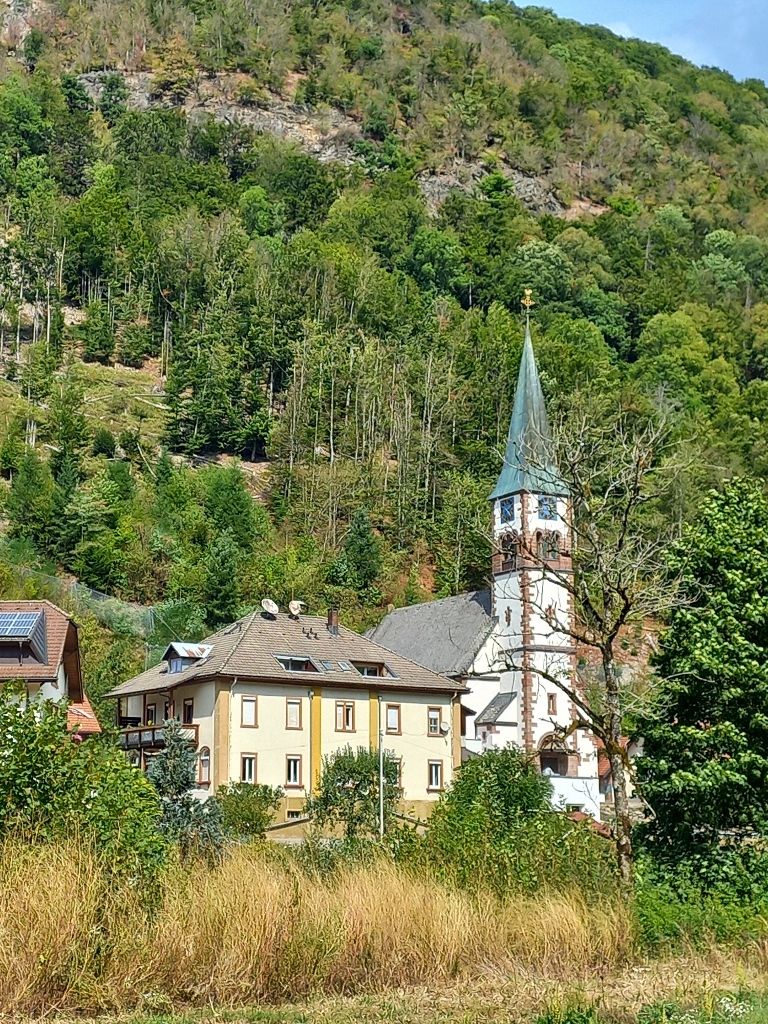 Church of Geschwend
Church of Geschwend
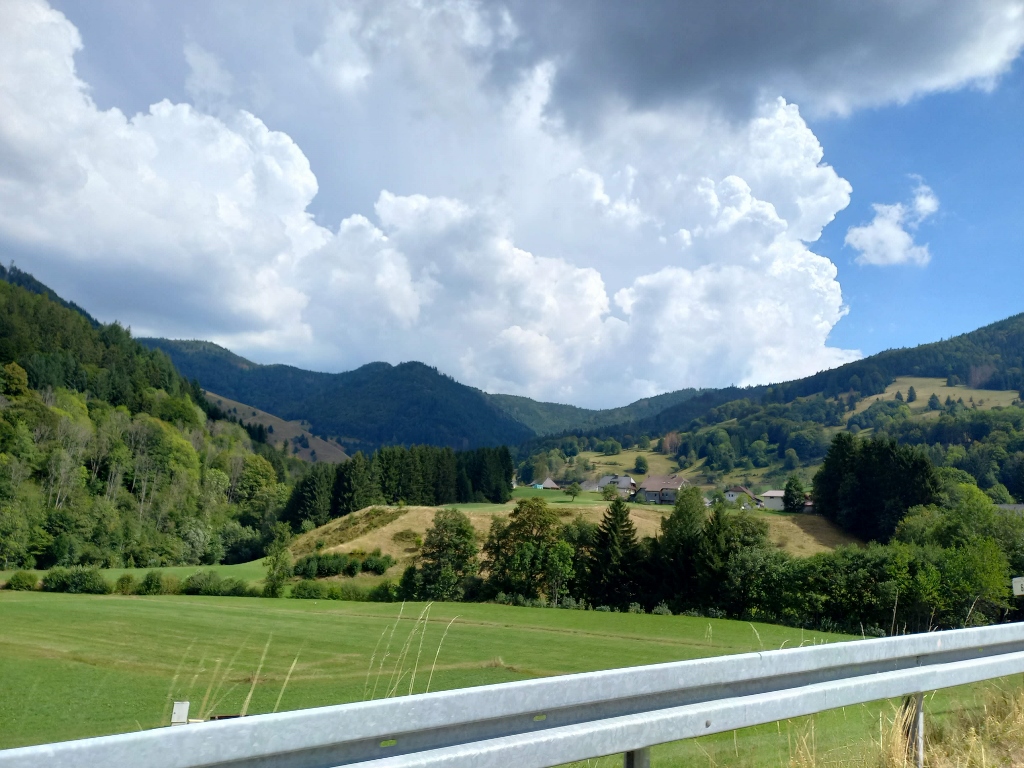 South Schwarzwald
South Schwarzwald
The route took me through the village of Präg which completely surprised me with its beauty and loveliness. The road seemed quite narrow to me and I did not know where to look first – at the winding road itself, at the navigation in the car, or the splendid flowers that decorated each and every window and each and every balcony in this village. I had no idea how big the village was, so I just drove through it in a short period of time and stopped only once I reached a parking that was located a little higher up. Well... The view was lovely from here, too.
 South Schwarzwald
South Schwarzwald
My next destination was a small town of Todtmoos. The main reason for coming here was the visit to the famous pilgrimage Church of Our Lady (Kirche Unserer Lieben Frau). I could see the church already from the parking lot where I left the car and first I walked a little uphill towards it, but then I changed up my mind and decided to walk around the centre of the place first.
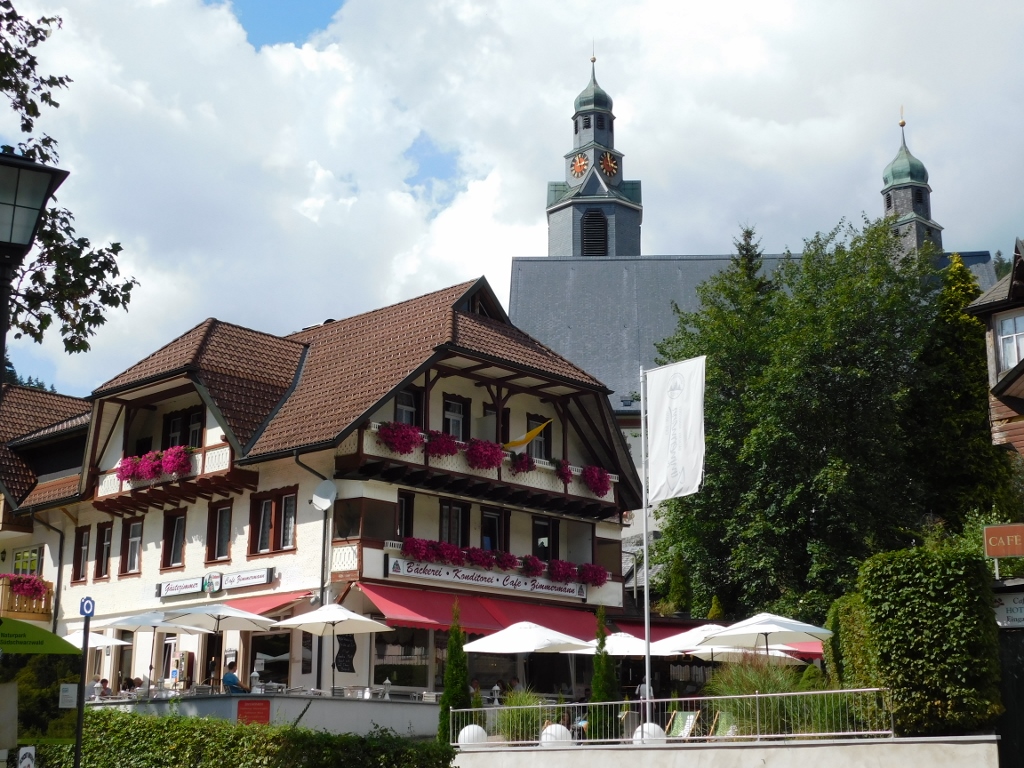 Todtmoos with the towers of the Church of Our Lady
Todtmoos with the towers of the Church of Our Lady
There were several reasons why I wanted to walk through the place first. As it can be seen in the previous photo, the houses in Todtmoos were also most often decorated with beautiful flowers and it felt good just to stroll and admire such sights. In addition, some of the houses were particularly lovely since they had been built in the traditional style, while some details were almost incredible, such as the facades made of wood shingles or windows that seemed as if they had just come out of a fairy-tale.
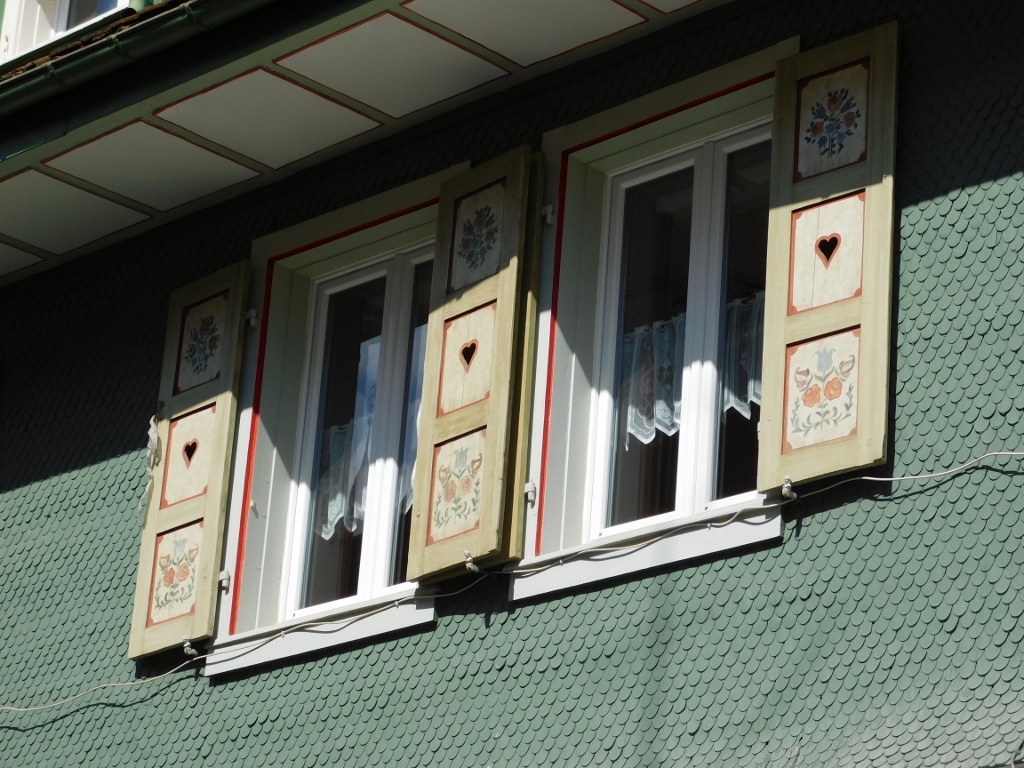 Todtmoos, a detail
Todtmoos, a detail
The other reason was that the centre of the small town was closed off to traffic (so I had had to drive around in order to find the parking lot) and this was because there was some kind of a fair that was already almost finished at the time when I arrived. I was not interested in any shopping whatsoever, but I thought it would be nice to walk there while there were still some stands opened.
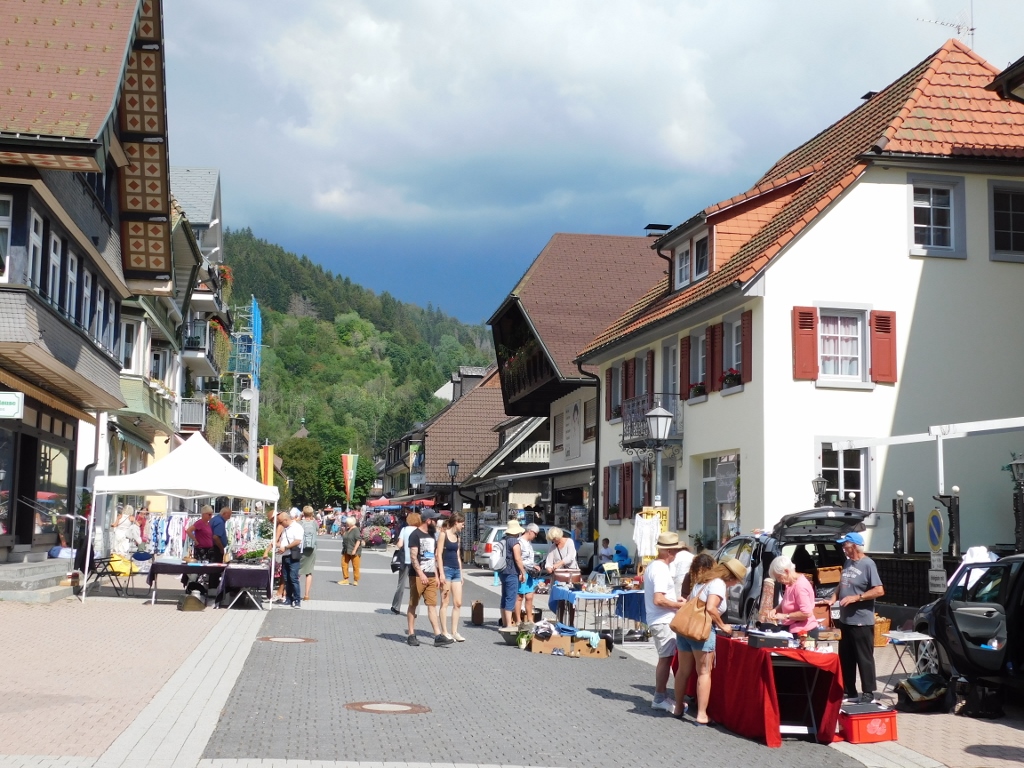 Todtmoos, a detail
Todtmoos, a detail
Then, following a different route I got to the church and approached it from the back side.
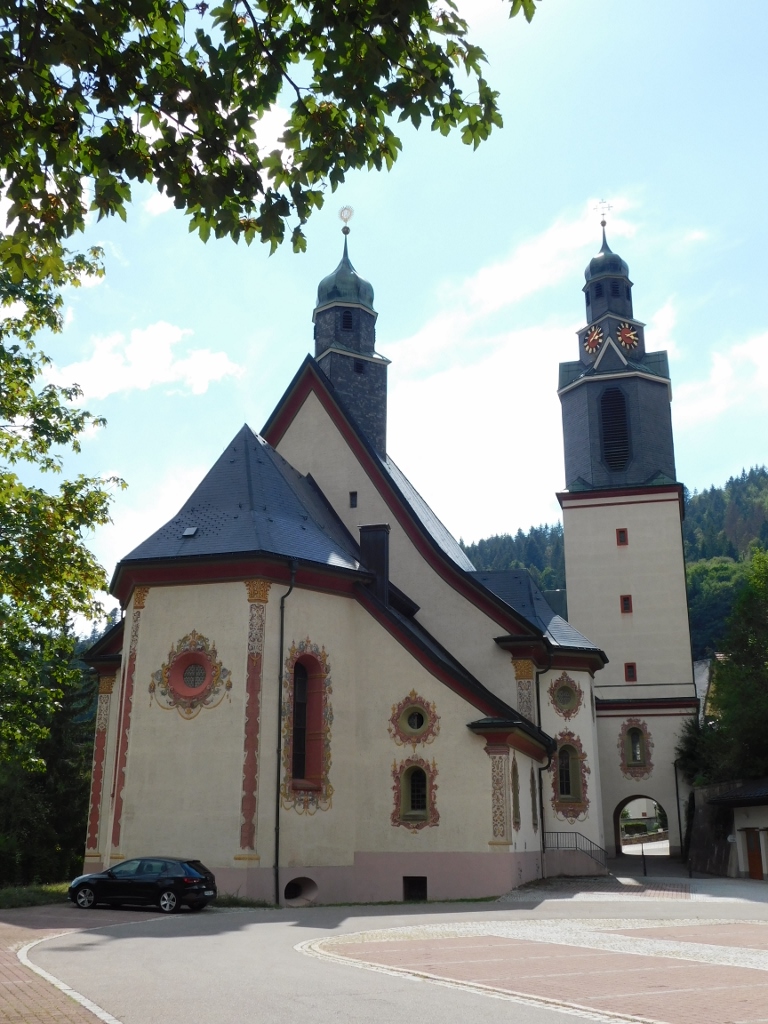 Pilgrimage Church of Our Lady in Todtmoos
Pilgrimage Church of Our Lady in Todtmoos
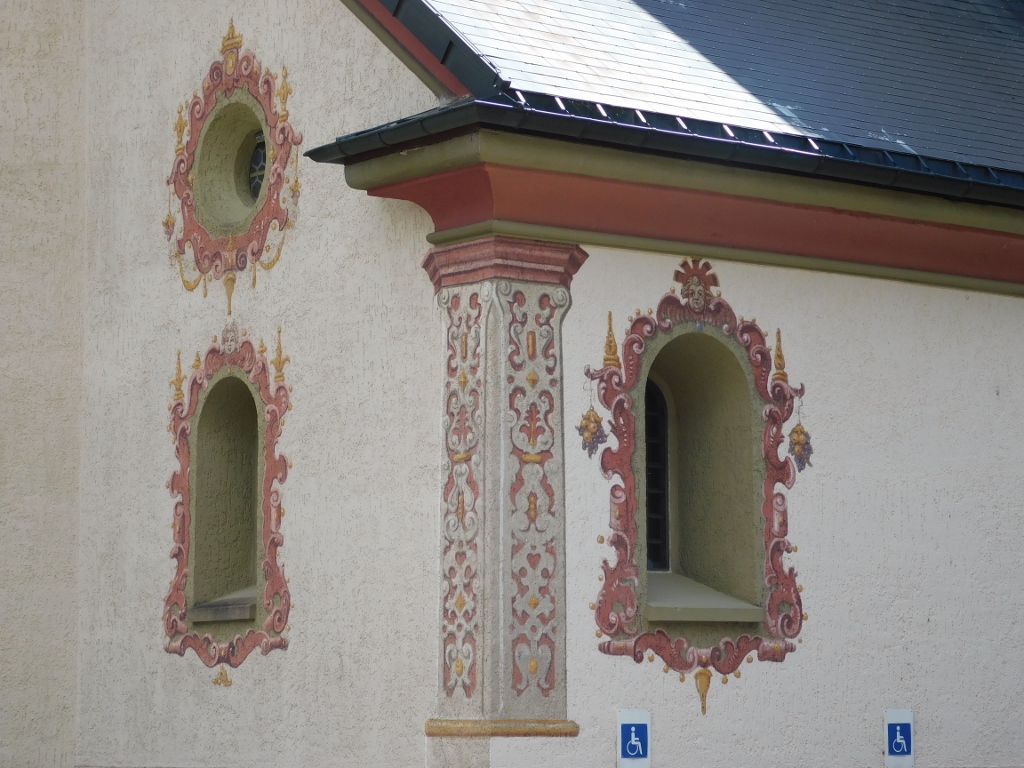 Church of Our Lady in Todtmoos, a detail
Church of Our Lady in Todtmoos, a detail
A chapel was built in this place already around the middle of the 13th century after an apparition of the Virgin Mary, but it was destroyed in a fire in the first half of the 17th century. Very soon it was repaired, but it got is final, Baroque appearance in the 18th century.
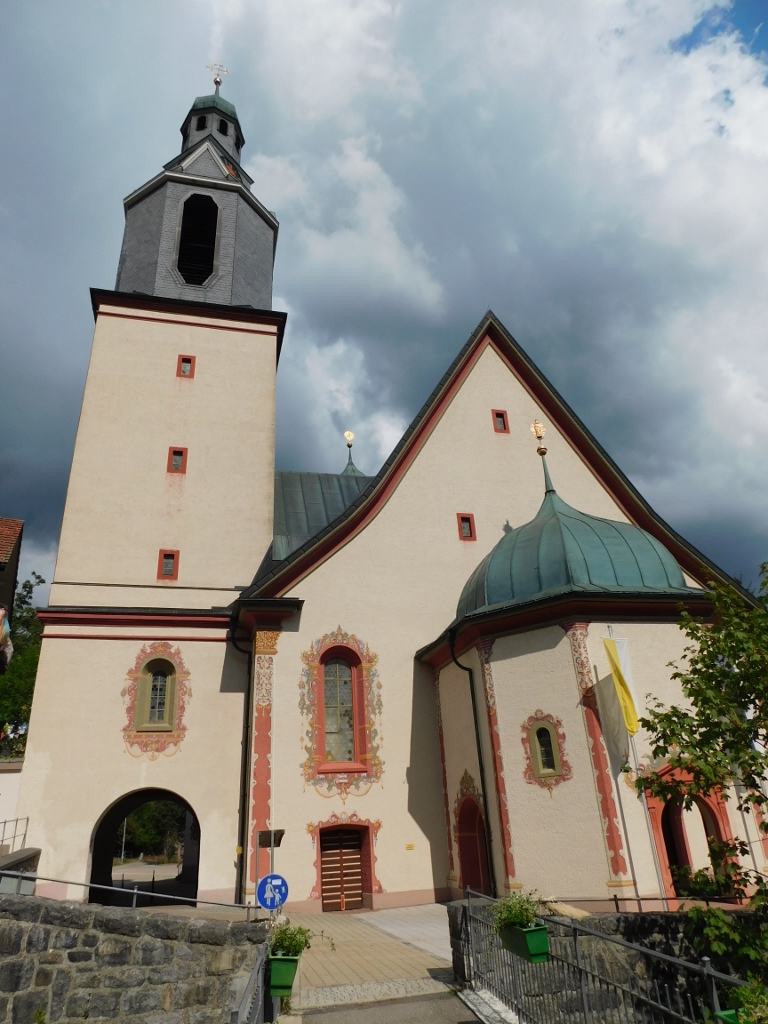 Church of Our Lady in Todtmoos
Church of Our Lady in Todtmoos
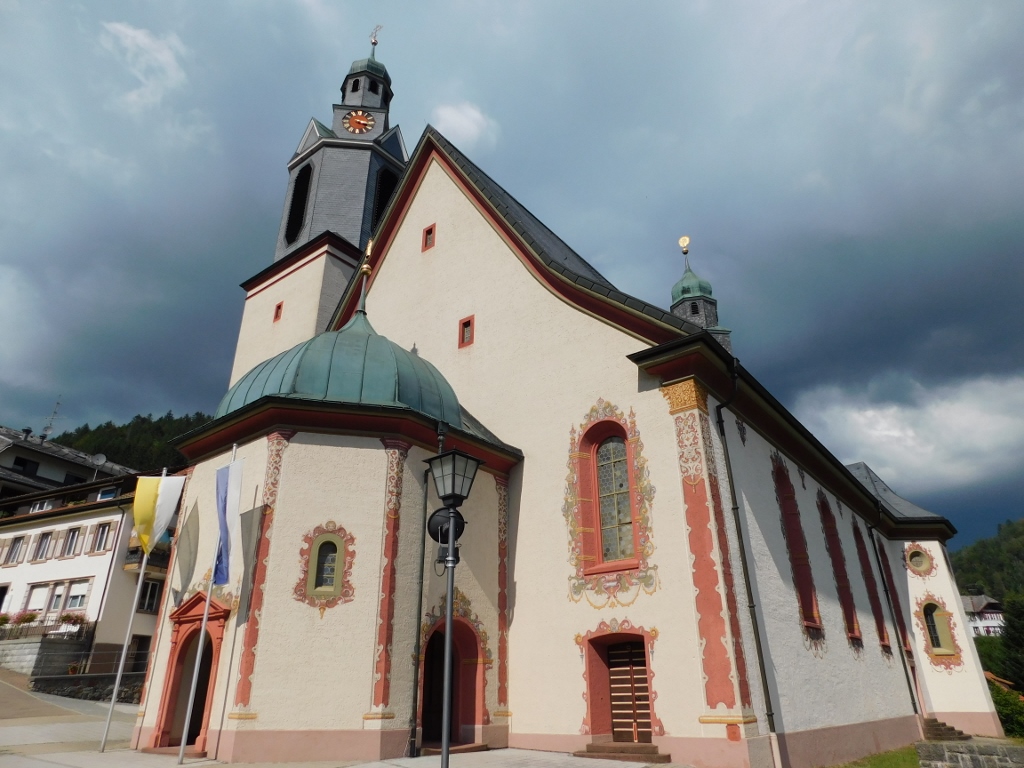 Church of Our Lady in Todtmoos
Church of Our Lady in Todtmoos
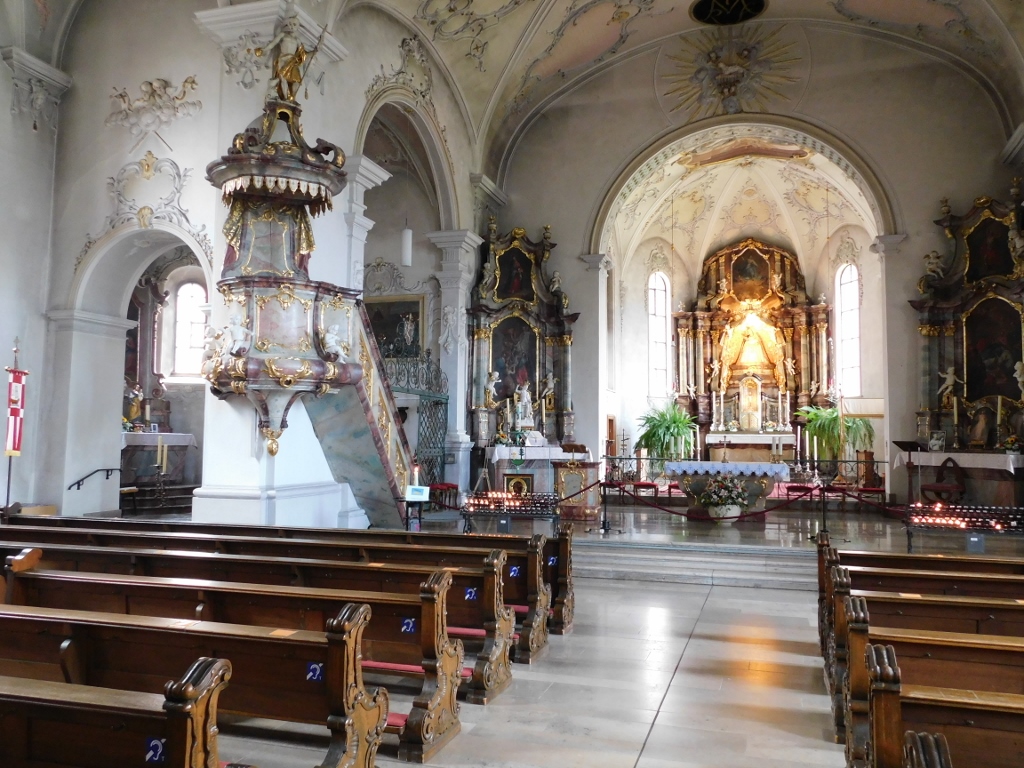 Church of Our Lady in Todtmoos
Church of Our Lady in Todtmoos
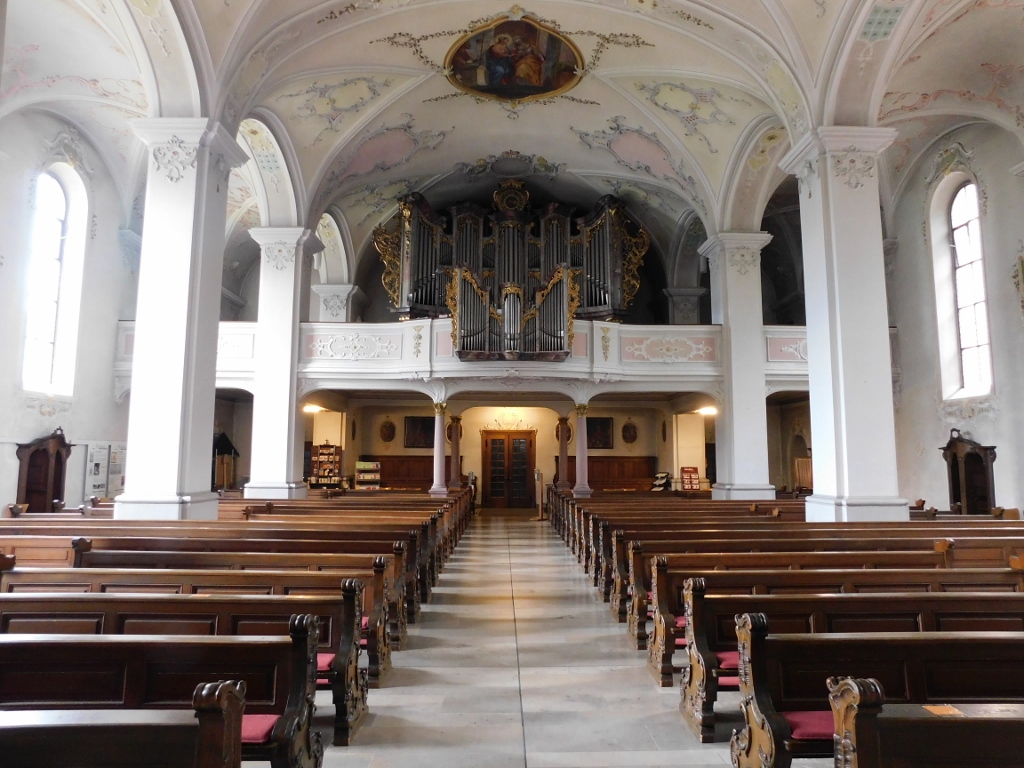 Church of Our Lady in Todtmoos
Church of Our Lady in Todtmoos
After the visit to the church, I went directly towards the parking lot and there, nearby, I took a seat at a restaurant where I had a light lunch. This time, since I drove on this day, I could only take water and coffee with it. That’s why I did not stay for too long.
I headed for Sankt Blasien, but the road first took me beside the Town Hall in Todtmoos and then I had to stop at the pertaining parking lot in order to be able to take nice photos. As it may be seen, almost all of the windows were decorated with flowers.
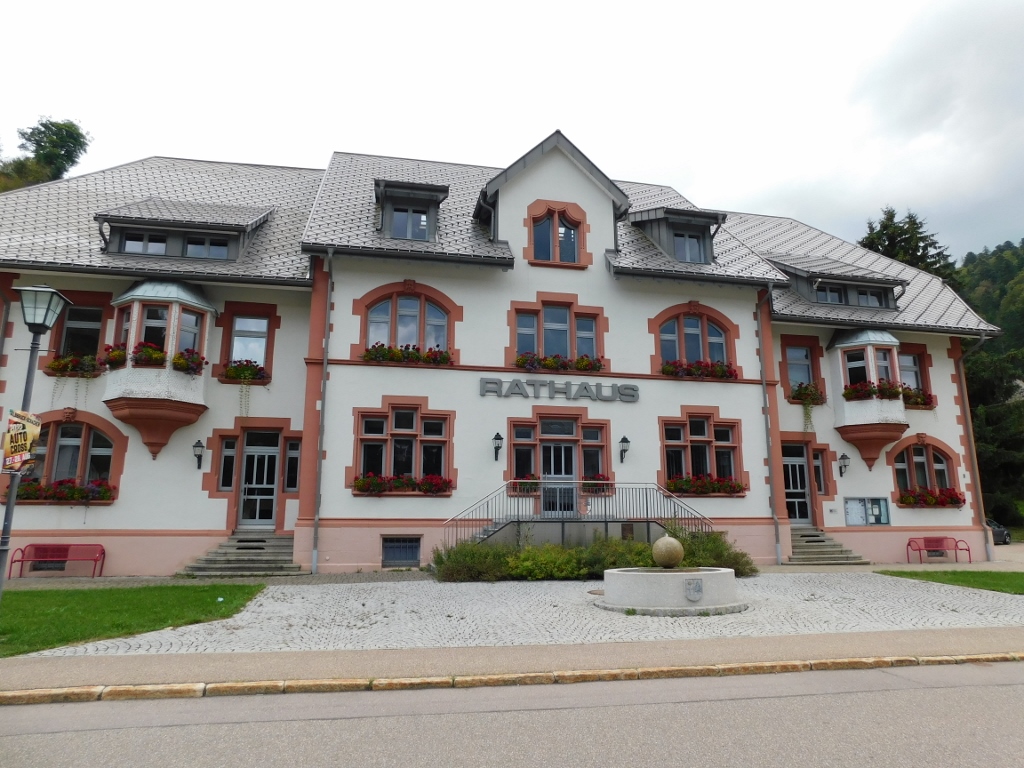 Town Hall in Todtmoos
Town Hall in Todtmoos
By the way, let me mention that for some 50 years, every year in January, i.e., in winter, there are dog-sleigh races organised here and they are, apparently, rather popular.
This was the right moment for me to get into the car since a heavy rain started to fall, as forecasted. Still, it did not last for too long and just as I arrived in Sankt Blasien, 14 km farther away, and found a parking lot, the rain had begun to stop and soon there was none. This provided me with a fine window to walk around this small town. Needless to say, it took me no time to spot a facade decorated by particularly nice flowers.
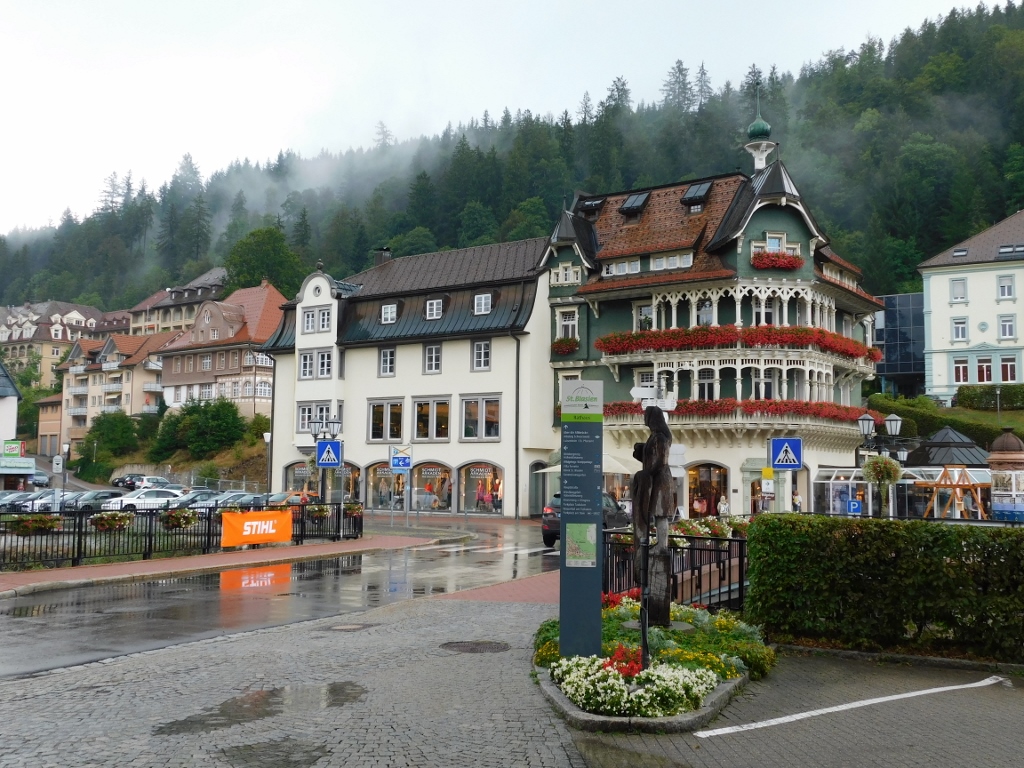 Sankt Blasien
Sankt Blasien
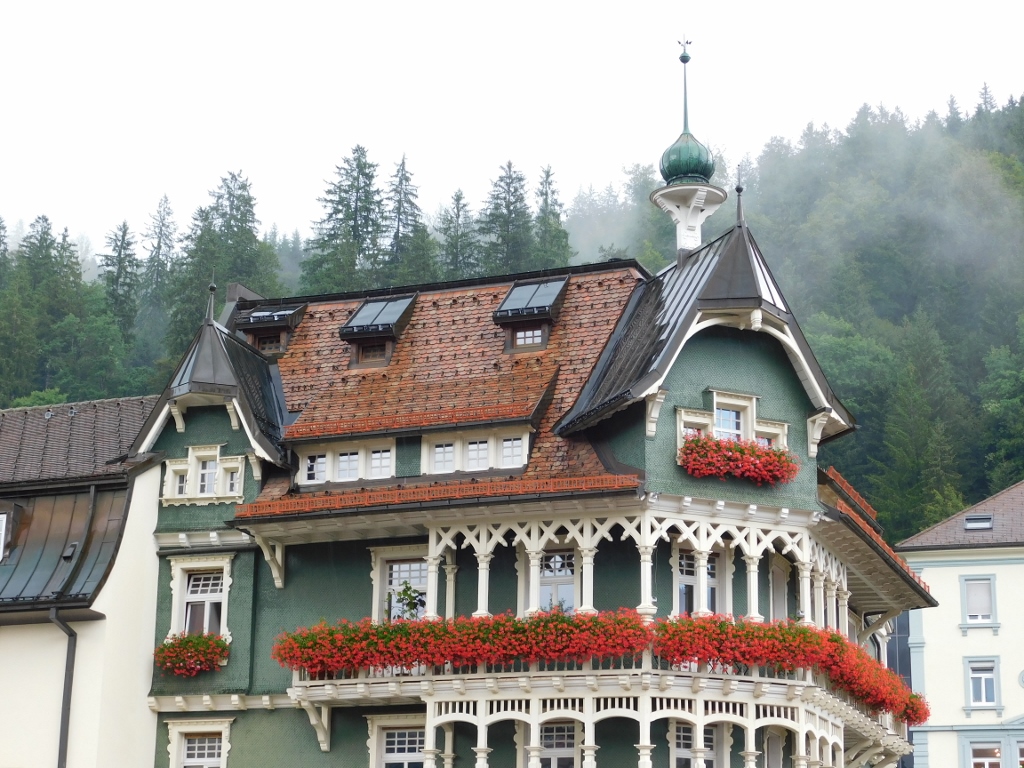 Sankt Blasien, a detail
Sankt Blasien, a detail
I walked through a passage within a building that is half hotel, half town hall, and so I reached a park where I noticed a sculpture showing the head of St. Blaise. The town’s name comes from this saint.
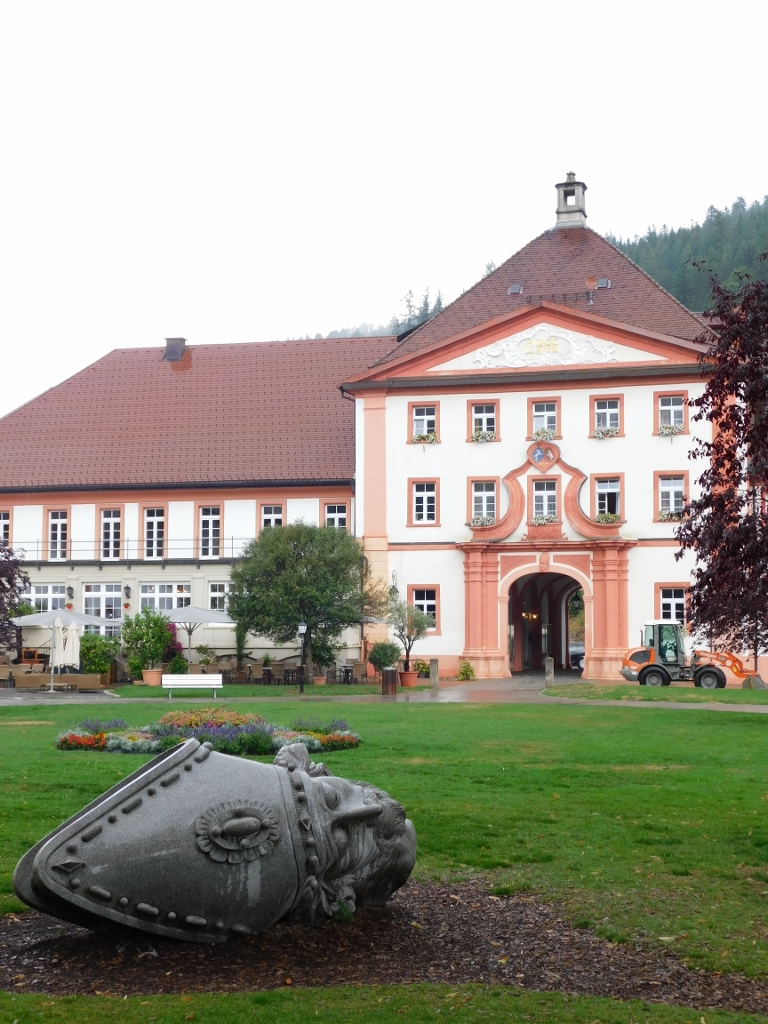 Sankt Blasien, a detail
Sankt Blasien, a detail
It seems that people of Sankt Blasien like to use one building for different purposes. Right next to the park, there is yet another building which is, according to what I could grasp from the guidebook and maps, half courthouse, half church. However, I did not care too much about the function of the building, but I did notice a sundial and a mural that can be seen on the south facade of this building.
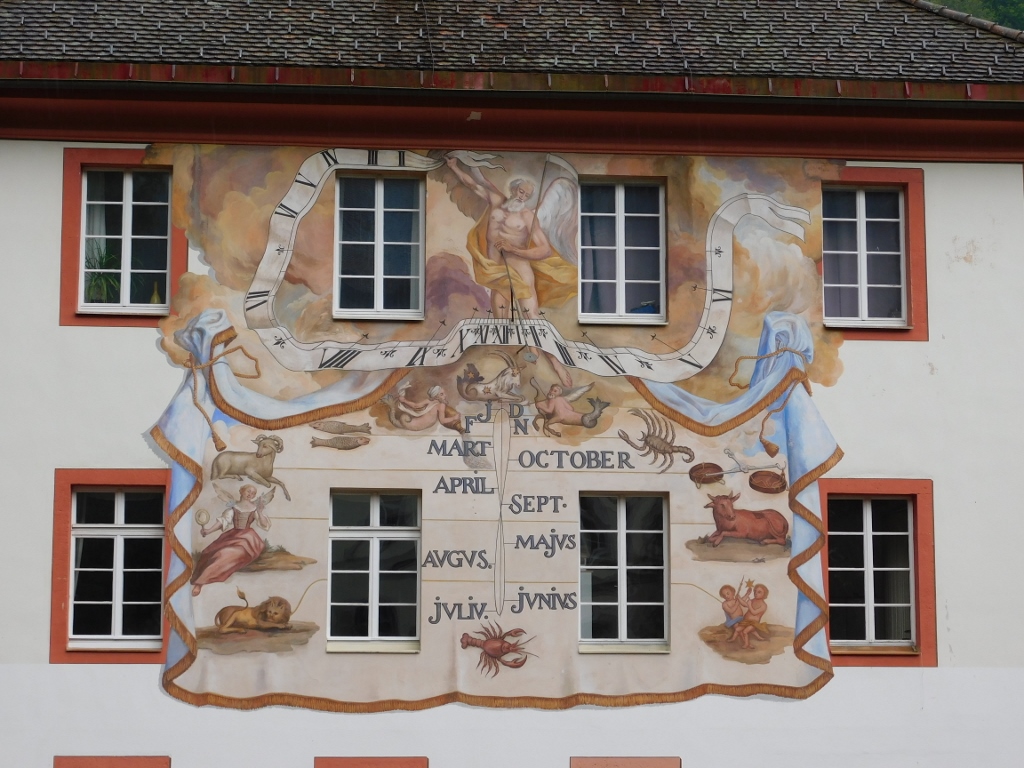 Sankt Blasien, a detail
Sankt Blasien, a detail
Sankt Blasien is a famous spa resort, but my main reason for coming to this town was its impressive Benedictine Abbey of St. Blaise (Kloster St. Blasien).
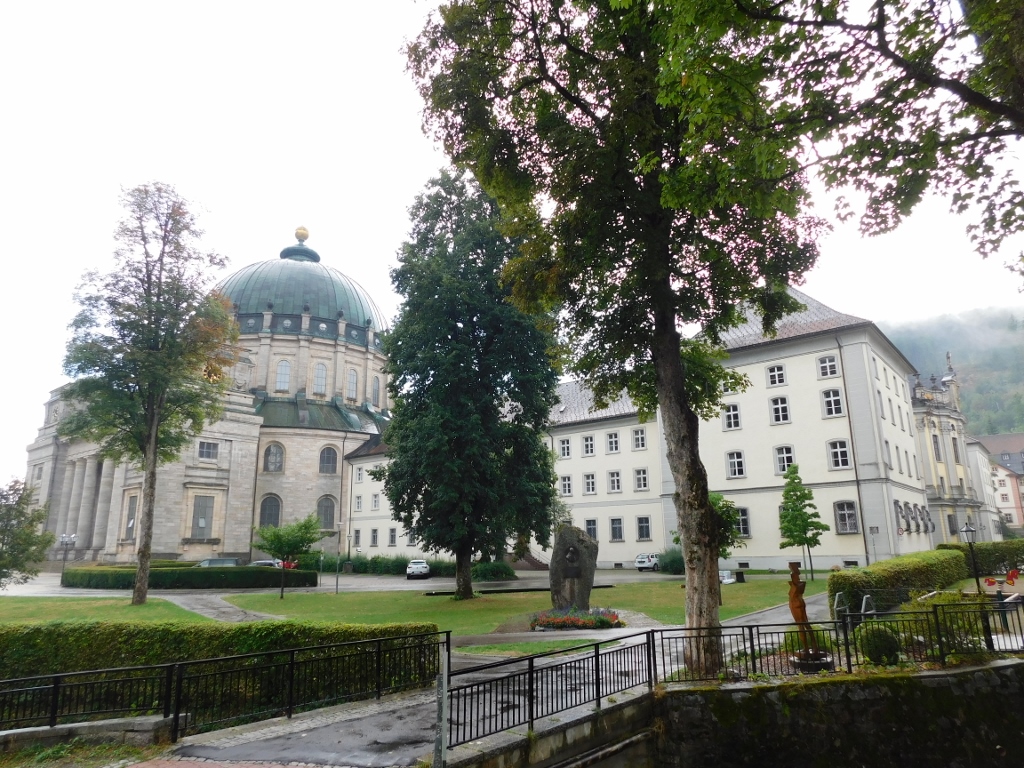 St Blaise’s Cathedral seen from the park
St Blaise’s Cathedral seen from the park
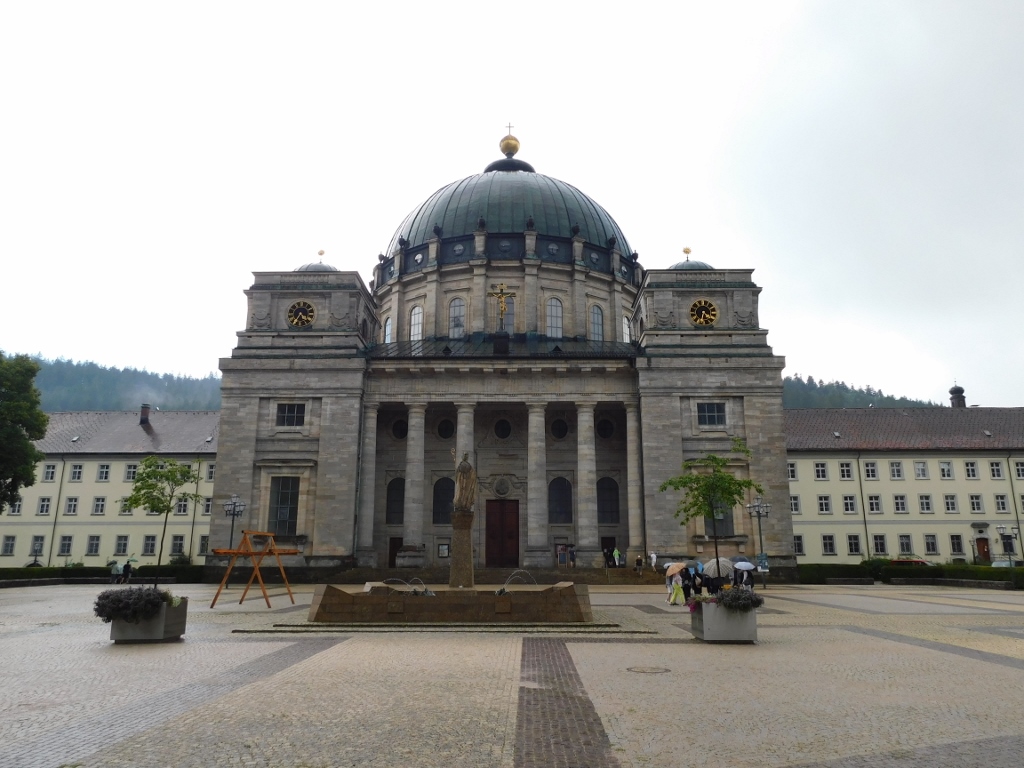 St Blaise’s Cathedral seen from the plateau in front of the church
St Blaise’s Cathedral seen from the plateau in front of the church
Since the historical data is rather inconclusive, the first religious edifice at this site was most probably built in the 9th century. Afterwards the abbey went through different phases and in 1806 it was dissolved, while the buildings that belonged to it were even used as factories. Still, since 1934 the buildings have been used as a renowned Jesuit college, Kolleg St. Blasien, a private and prestigious catholic secondary boarding school.
As for St Blaise’s Cathedral, the monastery church was destroyed in a fire in 1768, but the first mass was served in a new cathedral already in 1781.
The church that was built in the neoclassical style has a circular ground plan and it is characterised by a huge dome that is 46 m wide and 63 m high. It has been left with the name of St Blaise’s Cathedral (Dom St. Blasien) not because it continues to have this function, but because of the size and magnificence.
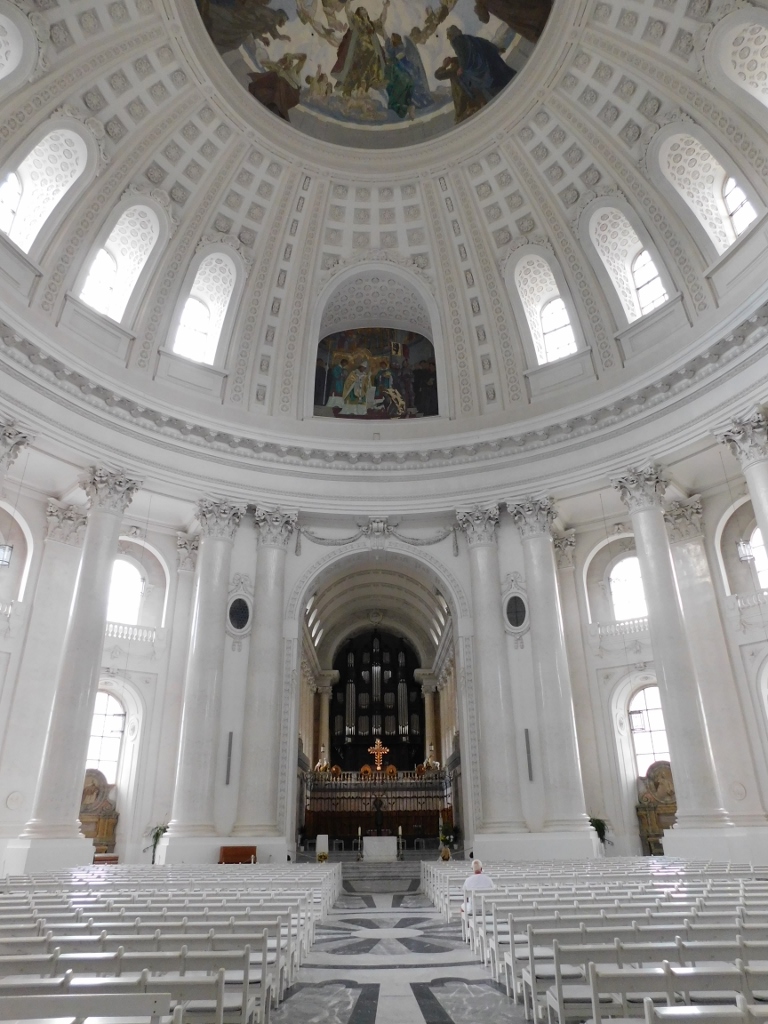 St Blaise’s Cathedral, a detail
St Blaise’s Cathedral, a detail
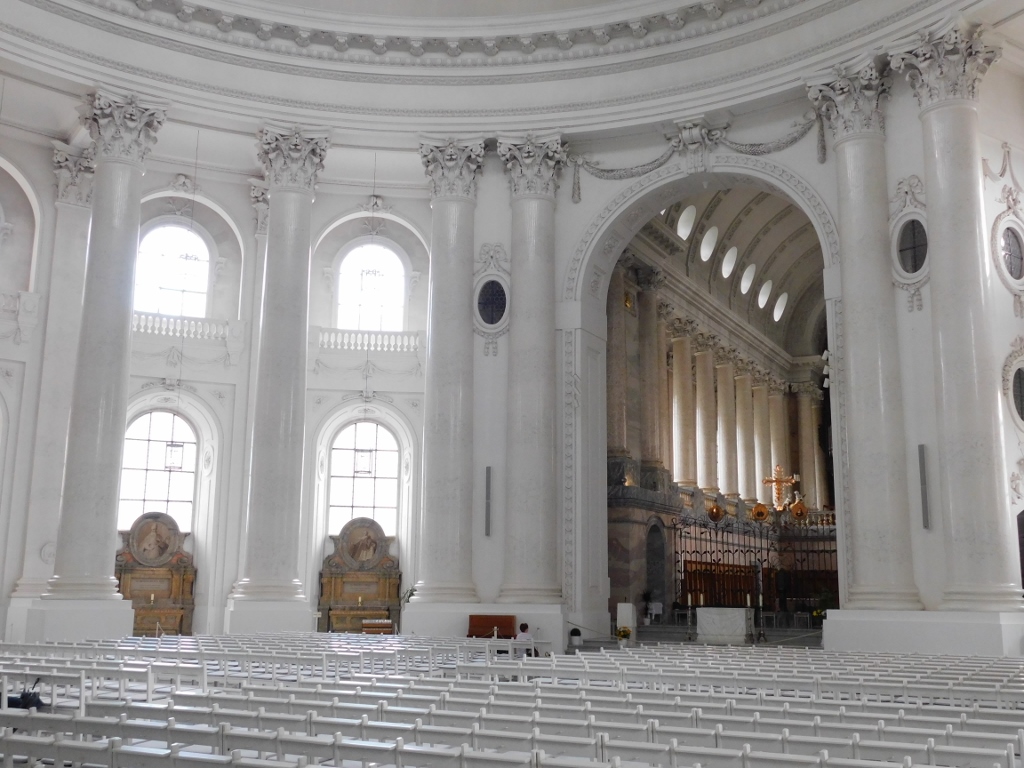 St Blaise’s Cathedral, a detail
St Blaise’s Cathedral, a detail
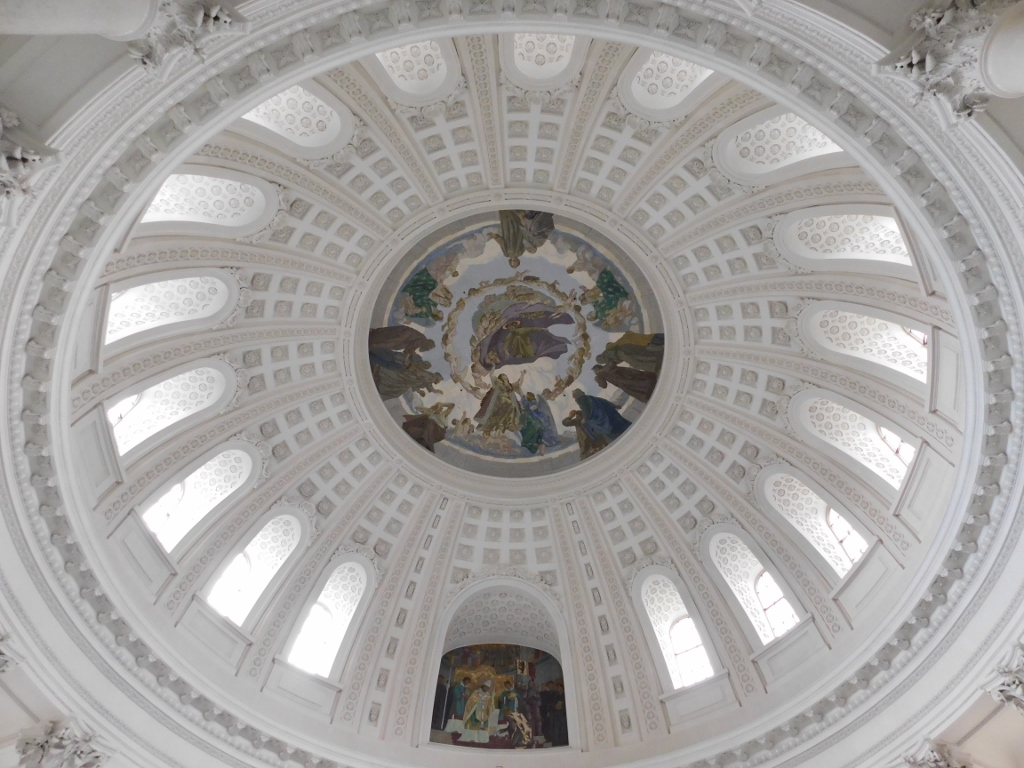 St Blaise’s Cathedral, a detail
St Blaise’s Cathedral, a detail
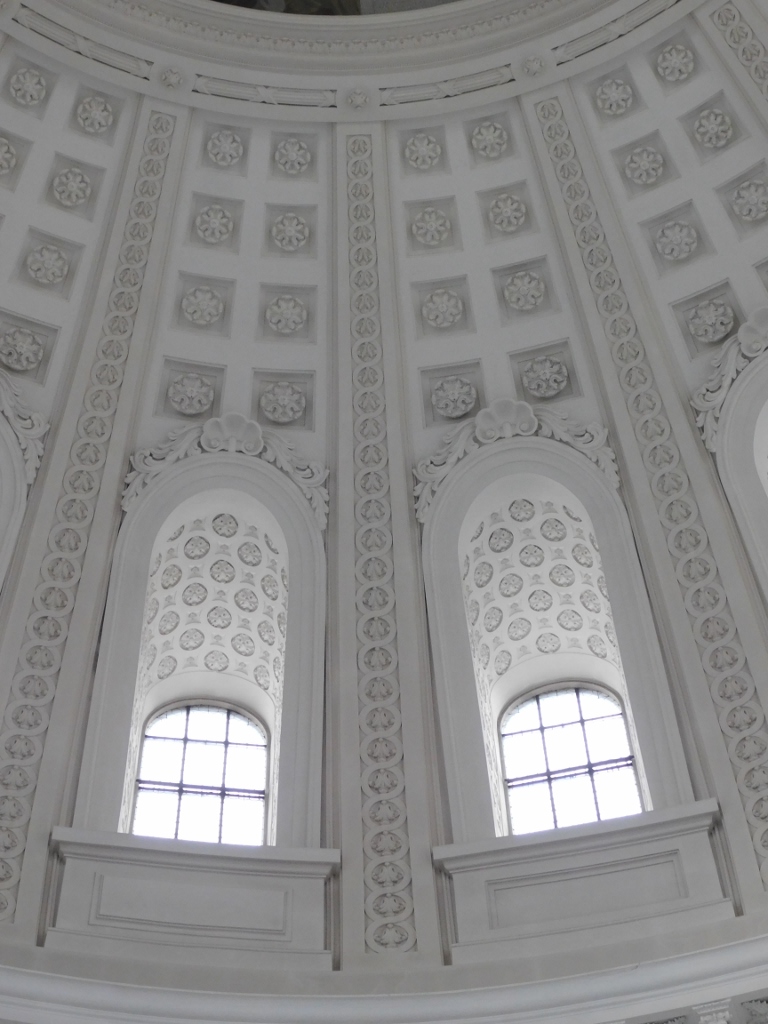 St Blaise’s Cathedral, a detail
St Blaise’s Cathedral, a detail
When I got out of the church, I walked a little around the buildings to which it is connected and which nowadays belong to the Jesuit college.
 Jesuit college in Sankt Blasien
Jesuit college in Sankt Blasien
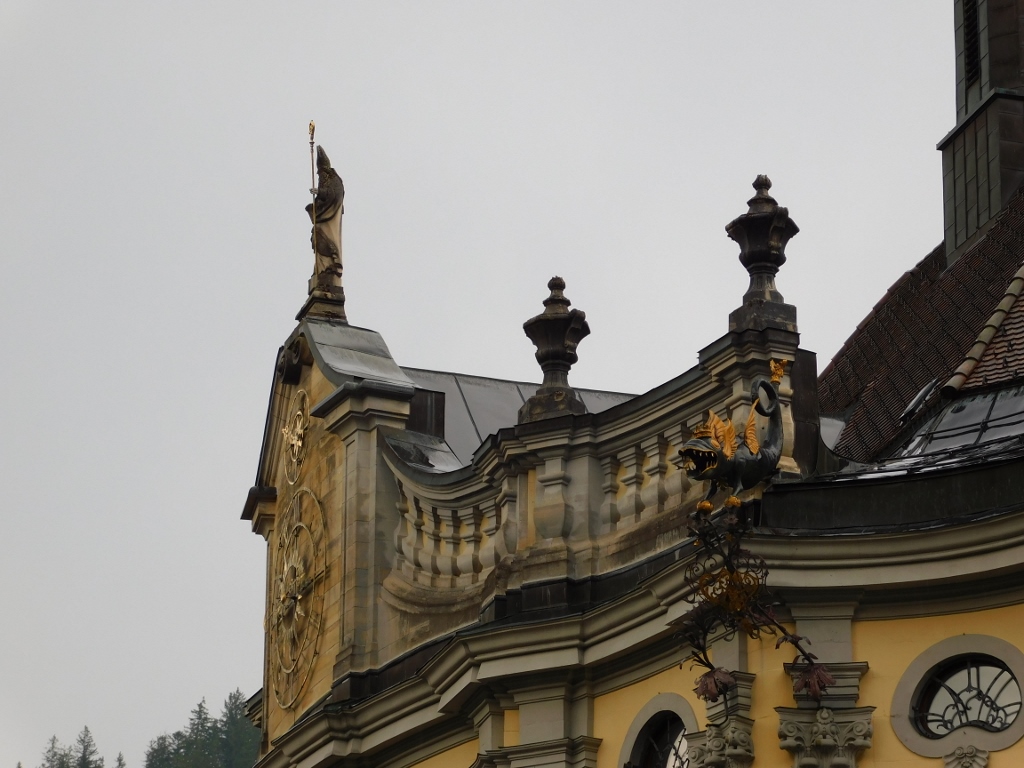 Jesuit college in Sankt Blasien, details of the main entrance facade
Jesuit college in Sankt Blasien, details of the main entrance facade
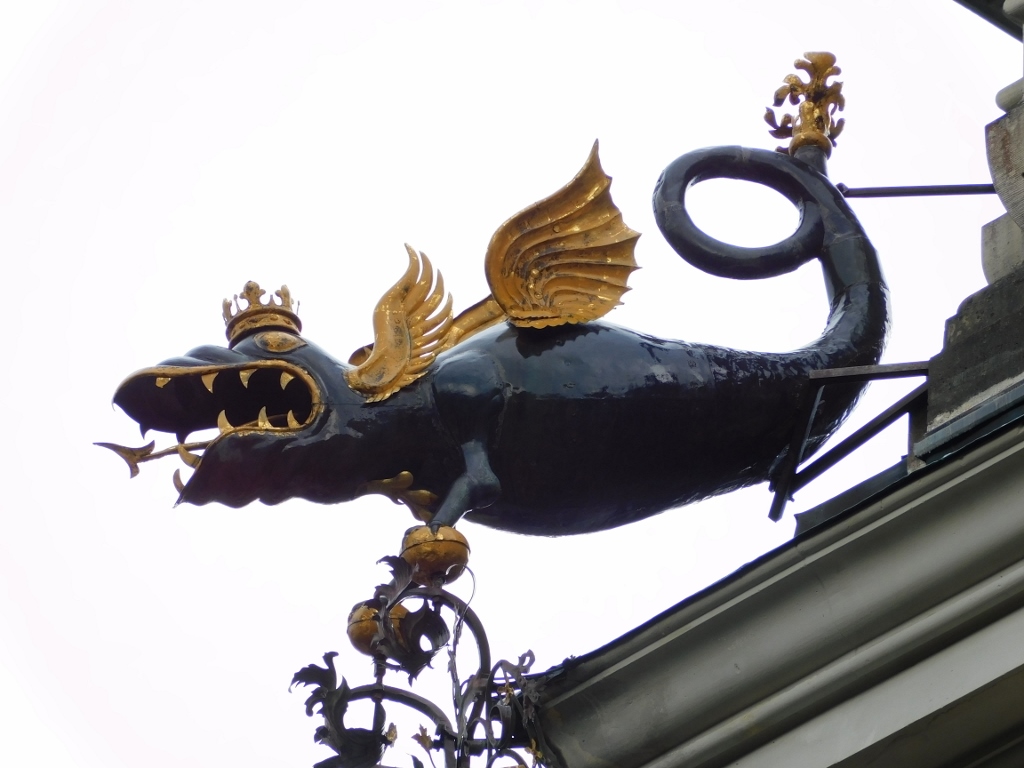 Jesuit college in Sankt Blasien, a detail from the main entrance facade
Jesuit college in Sankt Blasien, a detail from the main entrance facade
Then, crossing the park, I got to a street that led me to the parking lot and the car I had left there. Still, along the way, I noticed something very interesting. The local administration had sowed some plants in a concrete jardinière, including lots of mint, as well as tomatoes! The yield was very good this year. And this was all standing there out in the open.
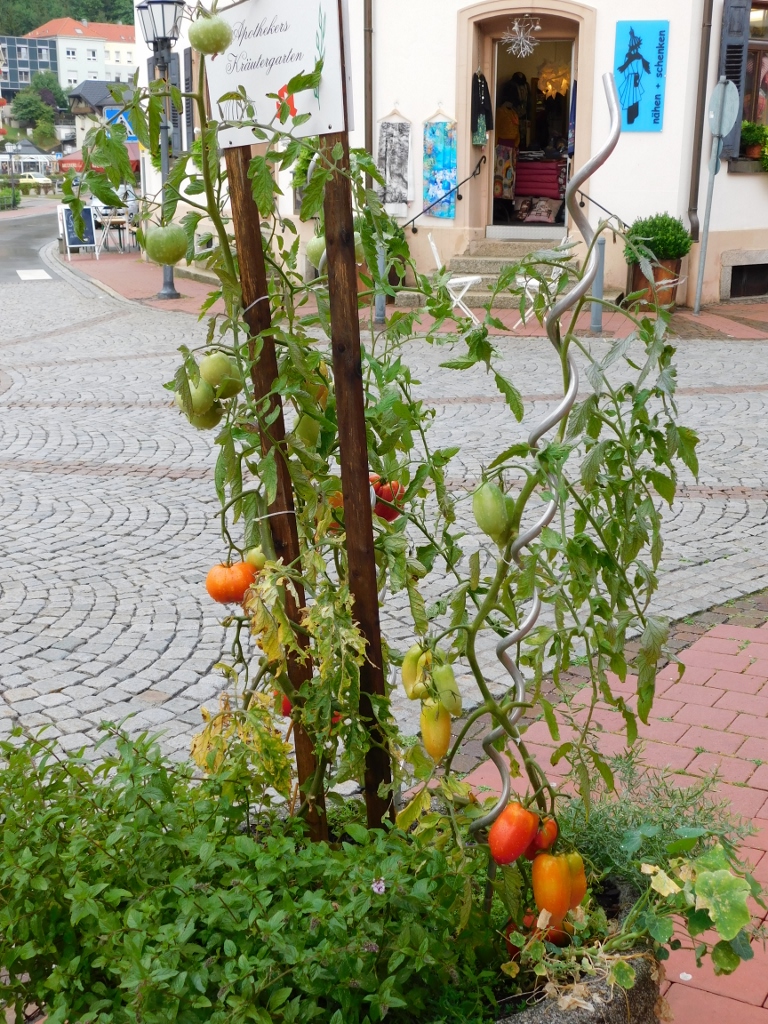 Public greenery in Sankt Blasien
Public greenery in Sankt Blasien
After this I got into the car and typed the name of the next destination in the navigation device that existed in the car. This next place, Schluchsee, is less than 15 km away and this distance can be covered in roughly 20 minutes. But, like most of the contemporary Homo sapiens I am also prone, luckily only occasionally, to replace my own brain by somebody else’s which is in this case named “the GPS.”
And so, I started to drive. The area I was passing through was enchanting. As there were still not many vehicles on the road, I could stop in the straight sections in order to take photos through the car window of the landscapes I was surrounded with. The whole sight was made additionally splendid after the rain – not only was everything “freshly washed,” but also the clouds and the evaporating steam gave their further flair.
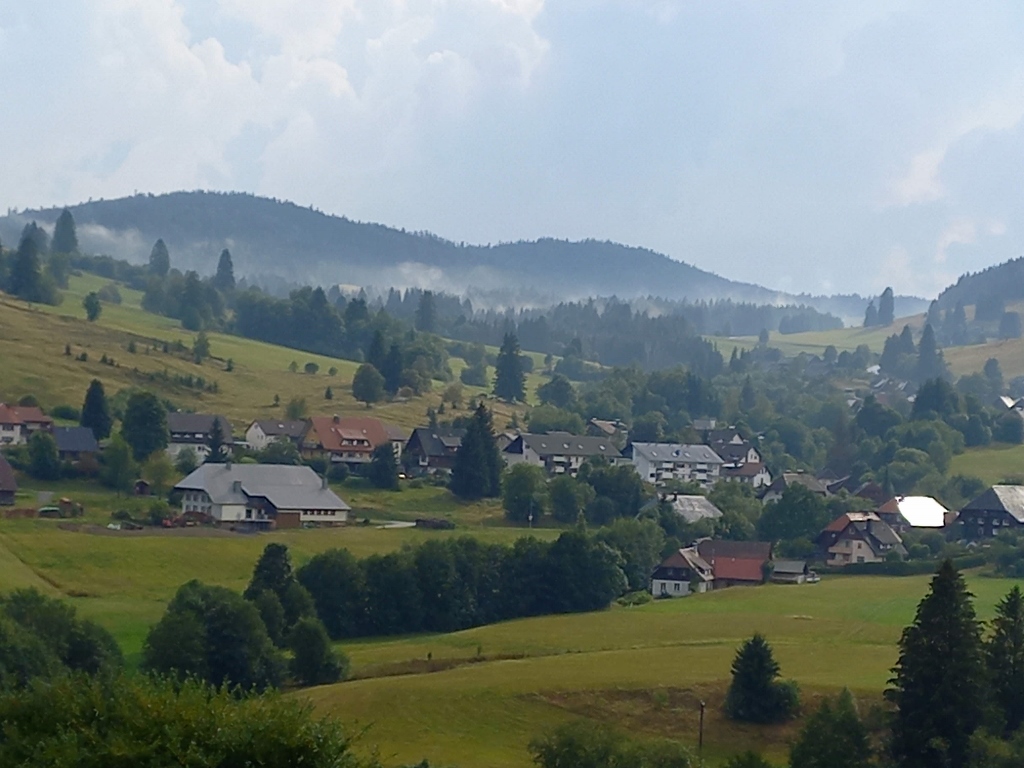 South Schwarzwald
South Schwarzwald
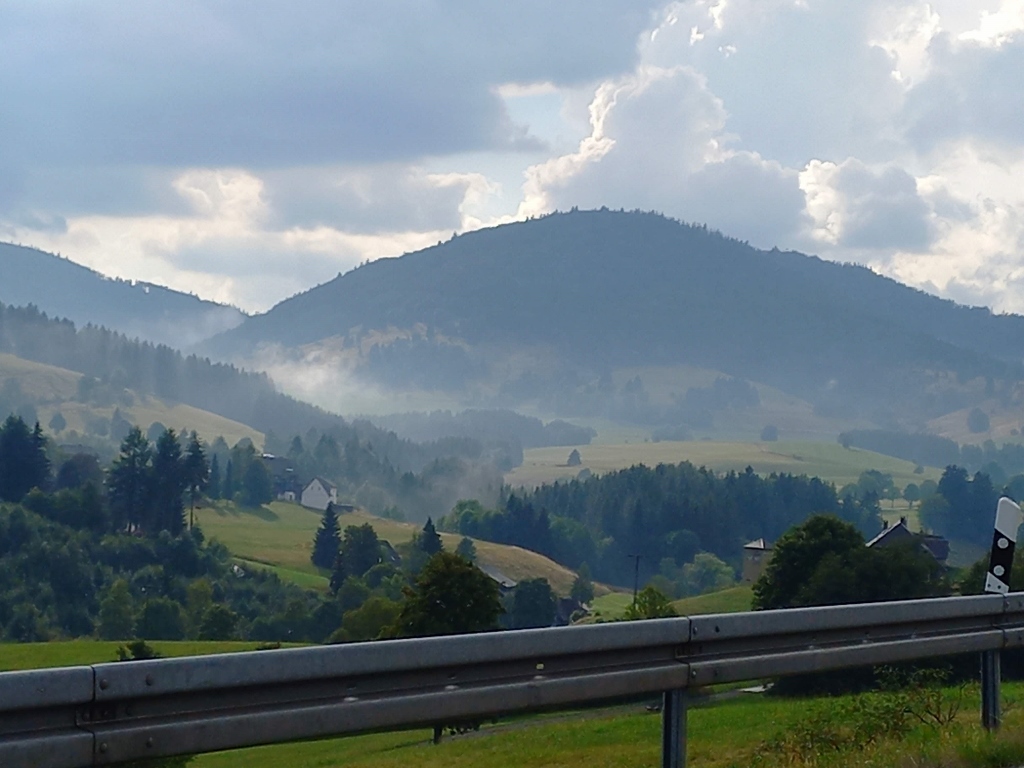 South Schwarzwald
South Schwarzwald
And then at some point I parked the car on a paved clearing that belonged to a private house, since I wanted to have just a couple of minutes to take photos at ease of what I could superficially see from the car.
 South Schwarzwald
South Schwarzwald
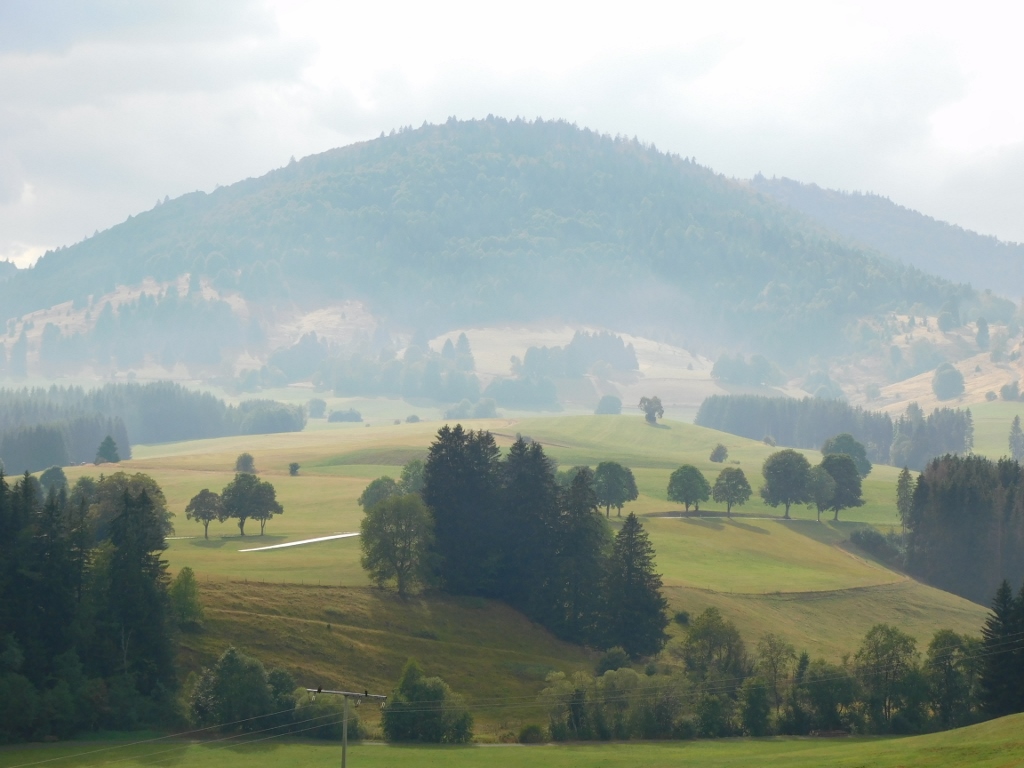 South Schwarzwald
South Schwarzwald
I did not see anyone and therefore nobody asked me anything, but I also did not bother anybody. I even took a photo of a beautiful fountain that belonged to that household.
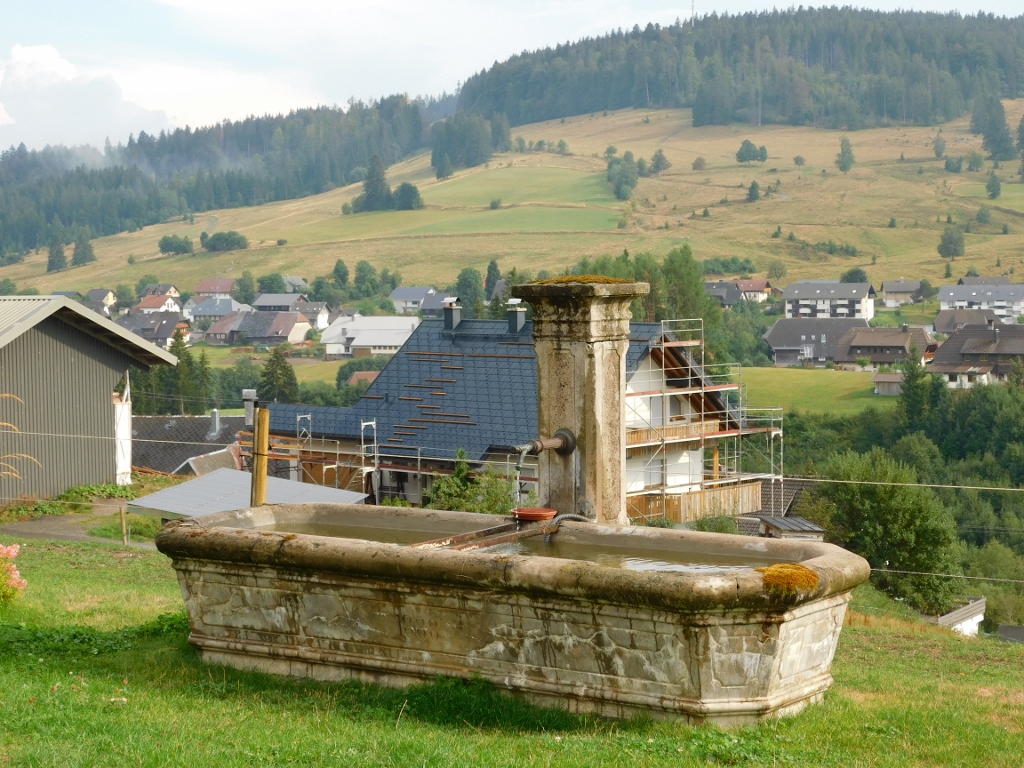 South Schwarzwald
South Schwarzwald
After this I continued driving following the instructions from the navigation device. The nature was still beautiful and then some of the landscapes started to seem familiar. Hmm?! When I got a few kilometres before Todtnau, I realised that I had actually come in the completely opposite direction to the one I wanted. I stopped on the side of the road in order to see what this was all about and then I realised that the GPS device was taking me in the direction of the waterfall where I had already been. For some reason, this destination remained in the device or rather it reappeared when I was typing in the new destination. Why it happened, I have no clue and at this point it did not matter for I had already gone far enough. As I was practically in the middle of the “circular way” to Schluchsee, I decided to continue in the same direction comforting myself that this was what “the higher power had in mind for me.” Needless to say, I did not receive anything in writing from the higher power, so I cannot claim that my supposition was true, but I ended up covering 60 km instead of 15 km and it took me 70 minutes instead of 20 minutes. However, I am rarely prone to despair, so I just said to myself that I had seen some wonderful landscapes and that was why I was not sorry for driving around.
All in all, at some point I did reach the town of Schluchsee that is located by a reservoir of the same name. While I was driving through the centre of the place it seemed very pretty and I wanted to stop there and walk a little, maybe even sit somewhere and have coffee. However, I could not find a parking lot, so I went down to a spacious parking lot close to the artificial lake.
And yet, I did not return to the centre, since I realised it was getting late. I was still supposed to go to another place and then back to Freiburg. In addition, it was completely cloudy now and it could start to rain any minute. That’s why I just took some photos from a distance of a part of Schluchsee and the parish church of St. Nicholas. The church itself is of a more recent date, but it incorporates the tower from the 13th century which most probably had the onion roof added in the 17th century. By the way, as it may be concluded from the following photo, it is possible to get here by train, too. There is a connection with Freiburg, but I must admit I did not inquire about the other ones.
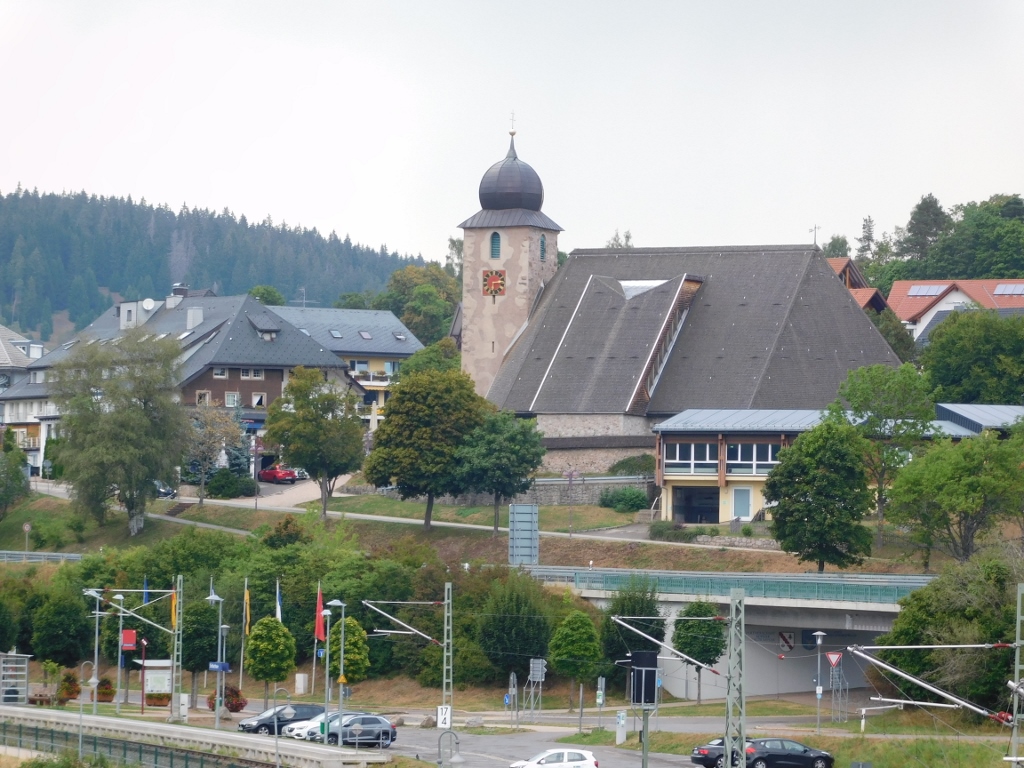 Schluchsee
Schluchsee
Instead of going to the centre of the town, I went down to the shore of the lake. In the past, this used to be a glacial lake, but because of a dam built in 1932 it was turned into a reservoir and now this is the largest stretch of water in the Black Forest (Schwarzwald). Also, this is the lake at the highest altitude in Germany – 930 m above sea level.
The lake and a couple of places that are situated on its banks are very popular. On the one hand, irrespective of the water temperature (it is cold even during summer on account of the high altitude), people gladly come here to swim or to sail across the lake. On the other hand, there are numerous waking and hiking trails around the lake and it is also possible to make a whole circle around it; the trail is around 18 km long and it is mostly flat.
 Schluchsee lake at the end of the summer season and when it is cloudy
Schluchsee lake at the end of the summer season and when it is cloudy
My next destination was yet another lake, but smaller and completely natural. This is the glacial lake called Titisee. On its bank there is a small town called Titisee-Neustadt which is renowned as a spa town, as well as a winter centre. I came here and parked the car, and then I went for a walk around the town and down to the lake.
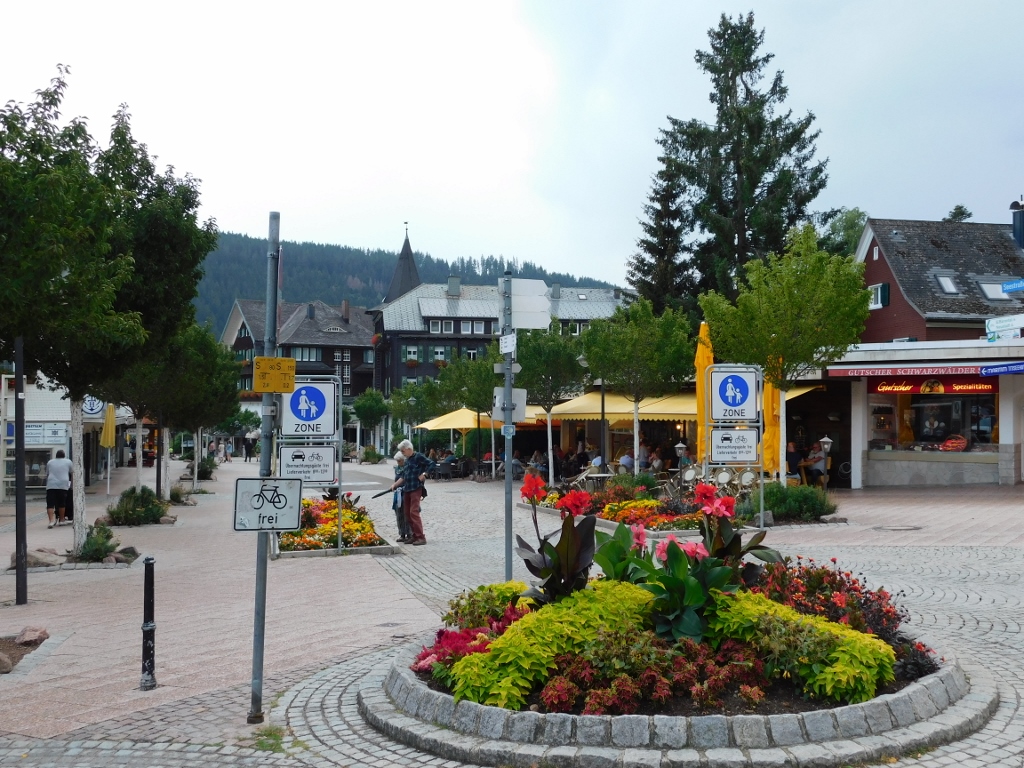 Titisee-Neustadt, a detail
Titisee-Neustadt, a detail
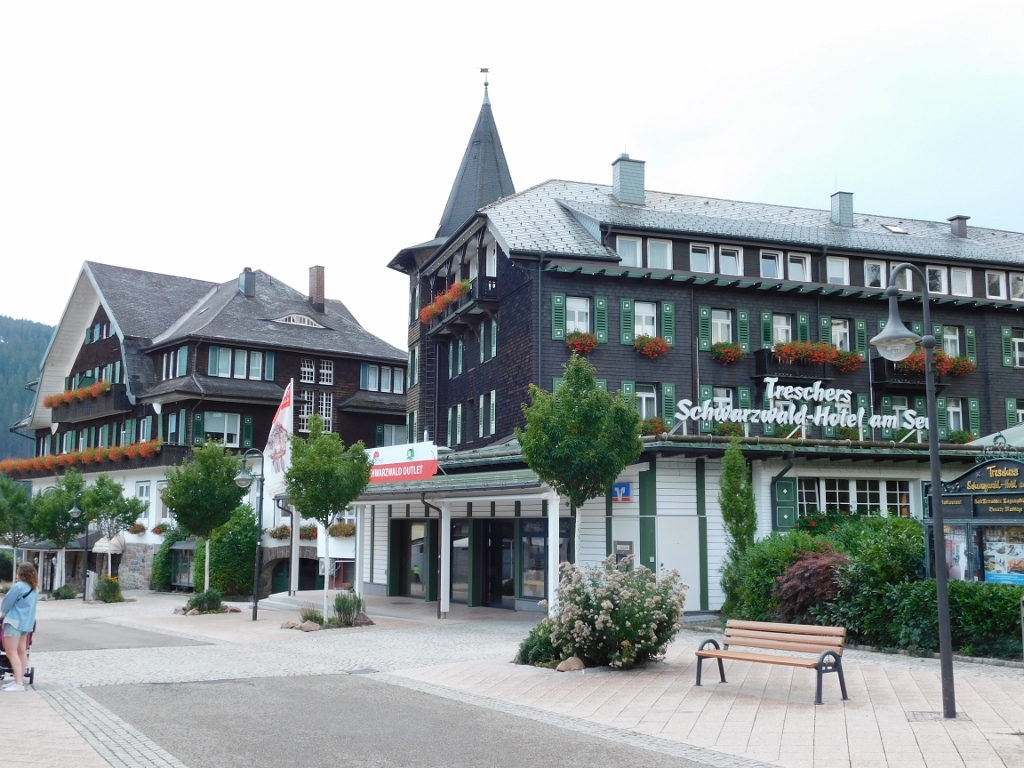 Titisee-Neustadt, a detail
Titisee-Neustadt, a detail
Needless to say, architecture is often very picturesque here as well, while the windows and balconies are frequently decorated with flowers.
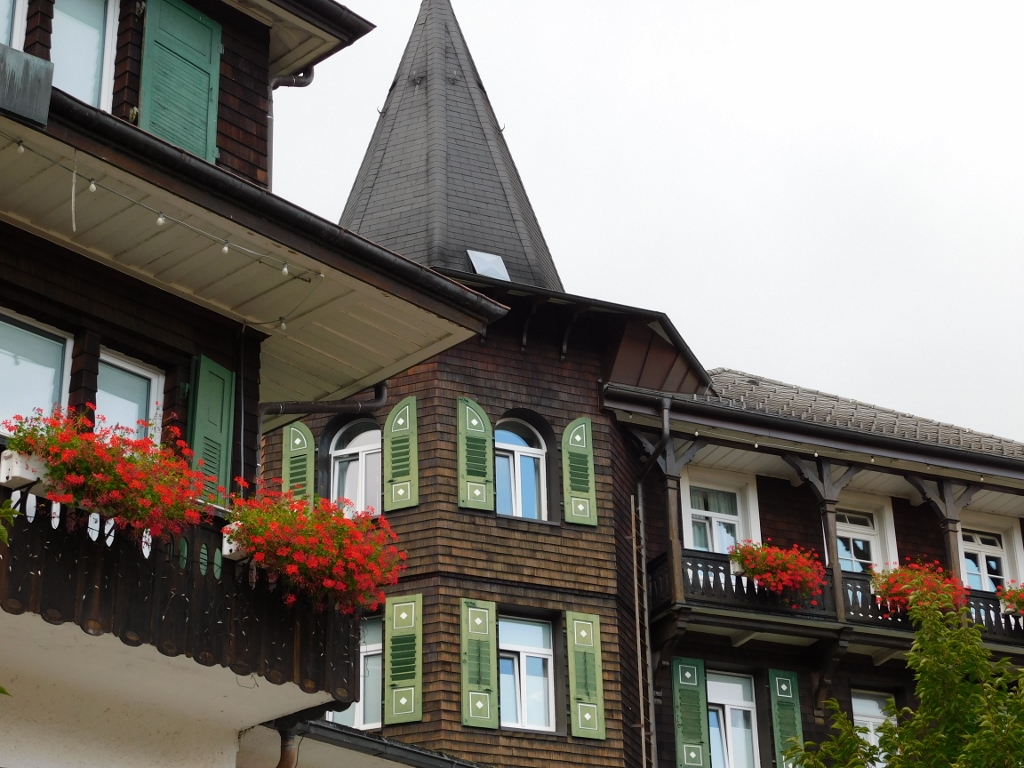 Titisee-Neustadt, a detail
Titisee-Neustadt, a detail
As for the lake, like in the case of Schluchsee, at the end of the summer season, at the end of the day and when it was cloudy, it was tranquil and undisturbed by humans.
 Titisee lake
Titisee lake
After this I started to go back to Freiburg. I felt rather tired, so I looked forward to my return to the hotel room.
There are several routes from Titisee lake to Freiburg that one can cover by car, but I opted for the one going through the Höllental gorge, which means “The Vale of Hell.” The road is significantly less dramatic than the name, but I should mention a section called “Hirschsprung” which is the narrowest part of the gorge. Originally, the gorge was only 9 m wide in this place and its name actually means “Deer’s Jump,” since it is said that a deer could jump over the gorge in this spot. As I had to be careful about my driving and there were a lot of cars, I didn’t even think of taking any photos, so all I’m left with is this story.
Soon I passed through Freiburg itself thus reaching the hotel. I was properly tired and needed a good rest, so I did not go out afterwards, plus there was a thunderstorm later on with heavy rain.
The following morning, after breakfast, I walked to the nearby station with passing local trains which I took in order to get to the centre of Freiburg.
Still, beforehand I enjoyed this walk through Gundelfingen, a German village that is practically a suburb of Freiburg, a city with over 200,000 inhabitants.
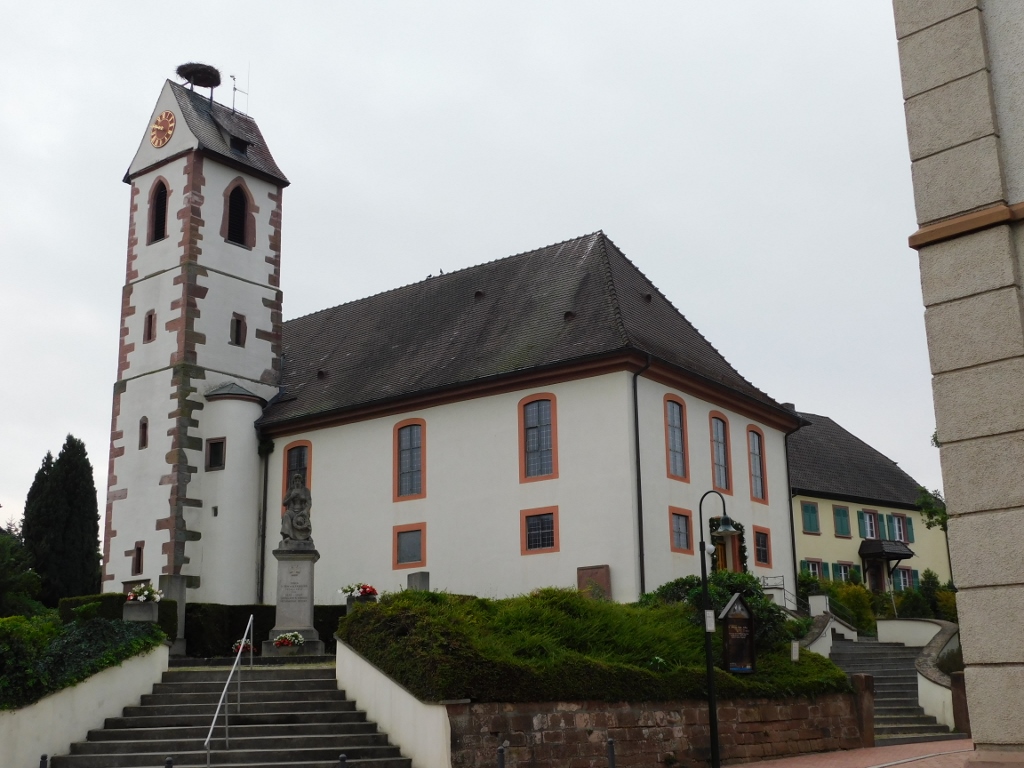 Evangelical church in Gundelfingen
Evangelical church in Gundelfingen
Most of the houses in this village have a contemporary appearance. I also walked past a few of them that were built in the half-timber style, but visibly maintained in line with contemporary practices. I quite like this architectural style, but I mostly thought about my impression that people here have an almost physical need to decorate additionally their houses and properties with flowers and various other details. After all, have a look at a couple of examples:
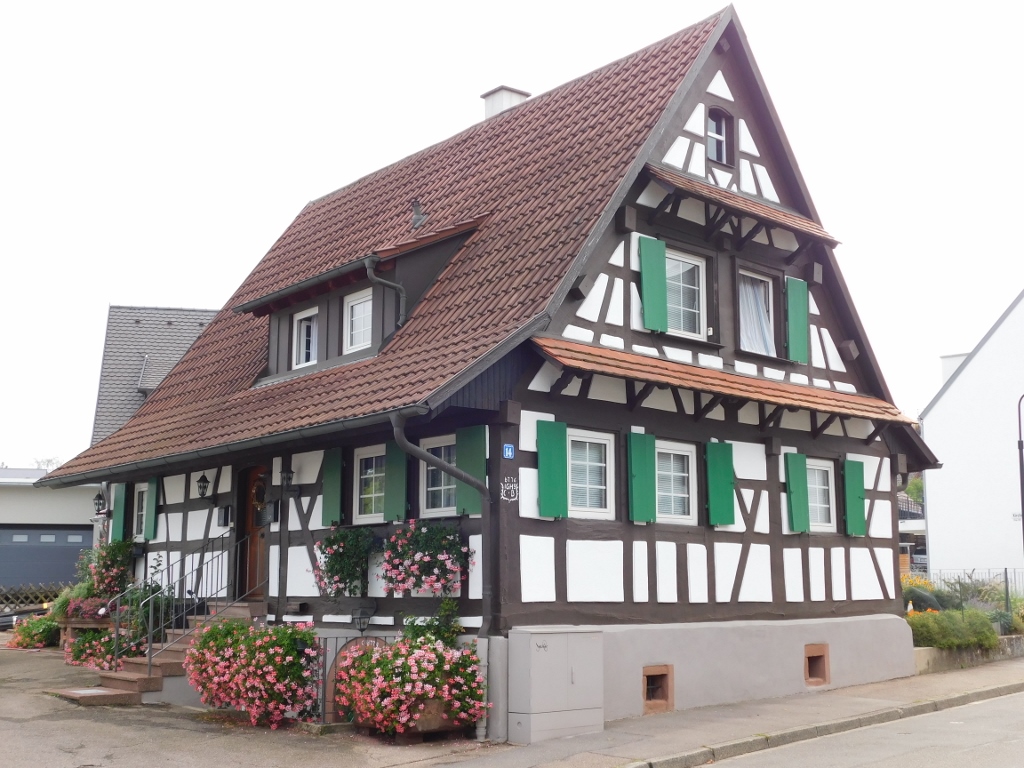 Gundelfingen, detail
Gundelfingen, detail
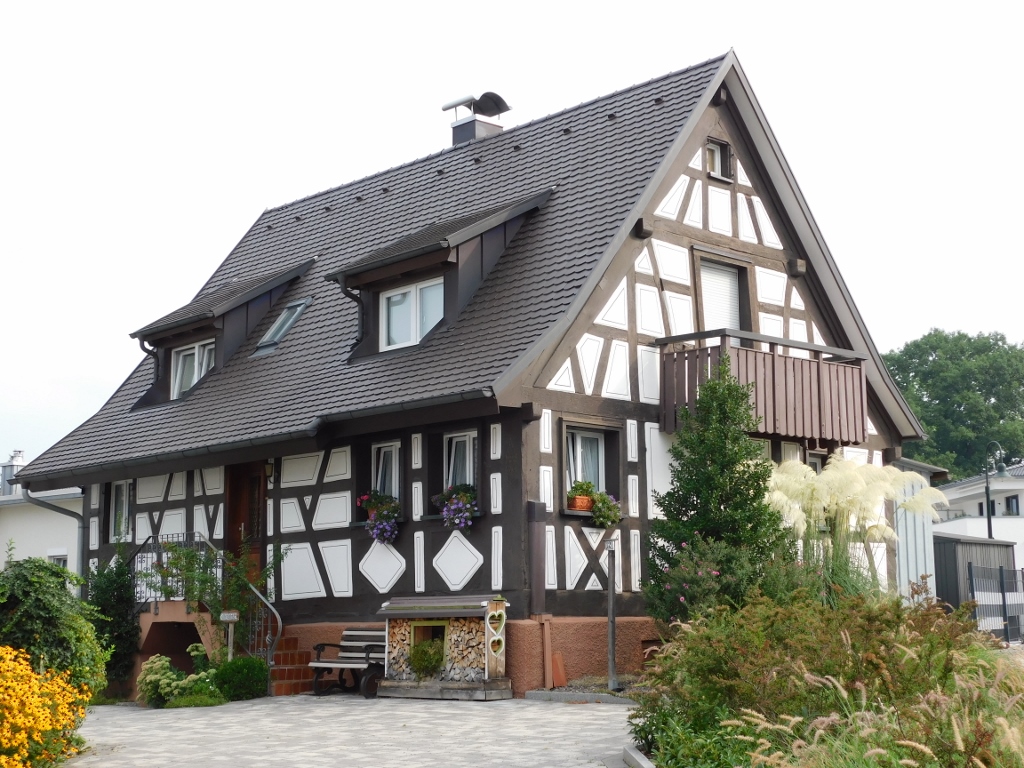 Gundelfingen, detail
Gundelfingen, detail